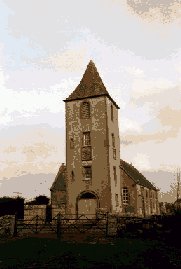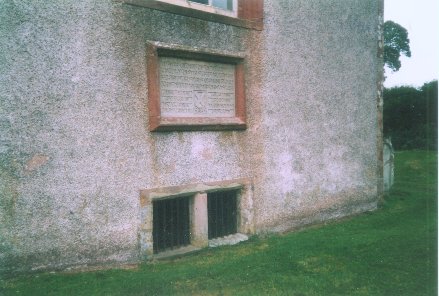Border Villages.
polwarth
Polwarth on the Green
Polwarth is a tiny village somewhere between the Border hills and the
North Sea, in that region of Scotland known as the Merse. Like so many places in the Borders it has had its share of lively history but, because of its position, it escaped much of the misery of reiver activity.
Today, the village cottages nestle comfortably among the trees as they have done
for centuries. The surrounding land was once water-logged mire, useful for defence. Now it has been drained and is rich farming land.
The Thorn Trees
In the middle of the sloping village green there stood two very old thorn
trees. It was the custom in times past, on the occasion of a marriage, as part of the celebrations, for all the villagers to dance around the trees. This old custom, which had prevailed for over 300 years, was discontinued during the 19th century.
The thorn trees are still
there but up to the present the old tradition has yet to be restored.
At Polwart-on-the-Green
We oft hae merry been
And merry we'll be still
While stands
the Kylic hill;
And round the corn bing
We'll hae a canty fling
And round about the
Thorn
We'll dance till grey-eyed -morn
Shall lift her drowsy bree
On mountain, vale and lea.
"At Polwart-on-the-Green
Our forbears oft were seen
To dance about the Thorn
When they gat
in their corn
So we her sons wha be
Shall keep their ancient glee."
It would appear that the villagers celebrated the harvest in the same fashion.
Polwarth Church
Some distance from the village, occupying a site of great beauty, the
church on the hill gleams visibly white amongst the trees. About it lies its small churchyard bearing witness to the families who have lived and died under its shelter.

The Church of Paulwothe dates back to the thirteenth century. Records show that it was dedicated to St. Mungo in I242. It was restored in 1378 after a period of decline. The existing church was rebuilt in the 18th century by Sir Patrick Hume, who had placed on the facade a tablet stating that a church had stood on the site since 900, and portions of the older
building of 1378 are still visible.
To the rear of
the church, on the eastern wall, is a barred aperture just above ground level which is the only, means by which light is shed into the black vault beyond, and should the morning sunshine falls upon the innermost crevices of the vault, there may be seen the ends of two coffins of the Marchmont family.

In the churchyard at Polwarth is a gravestone with
the inscription:
Remember man as thou goest by,
As thou art now so once was I
As I am now so must ye be,
Remember man that ye most dee."